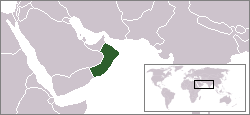

The history of the Jews in Oman reaches back to the 800s. There was a Jewish presence in Oman for many centuries; however, the Jewish community of the country is no longer in existence.


The history of the Jews in Oman reaches back to the 800s. There was a Jewish presence in Oman for many centuries; however, the Jewish community of the country is no longer in existence.
The documented Omani Jewish community was made famous by Ishaq bin Yahuda, a merchant who lived in the 9th century. Bin Yahuda lived in Sohar, and sailed for China between the years of 882 and 912 after an argument with a Jewish colleague, where he made a great fortune. He returned to Sohar and sailed for China again, but his ship was seized and bin Yahuda was murdered at the port of Sumatra.
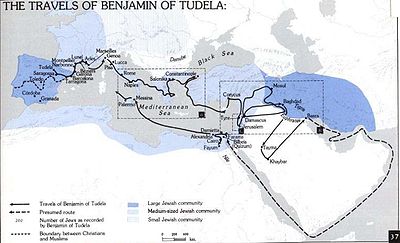
A historical journey to visit far-flung Jewish communities was undertaken by Rabbi Benjamin of Tudela from 1165 to 1173 that crossed and tracked some of the areas that are today in the geographic area of Oman. His trek began as a pilgrimage to the Holy Land. [2] He may have hoped to settle there, but there is controversy about the reasons for his travels. It has been suggested he may have had a commercial motive as well as a religious one. On the other hand, he may have intended to catalogue the Jewish communities on the route to the Holy Land so as to provide a guide to where hospitality may have been found for Jews travelling to the Holy Land. [3] He took the "long road" stopping frequently, meeting people, visiting places, describing occupations and giving a demographic count of Jews in every town and country.
One of the known towns that Benjamin of Tudela reported as having a Jewish community was Muscat [4] located in the area of Oman in the northern part of the Arabian Peninsula.
In the mid-19th century, the British Lieutenant James Raymond Wellsted documented the Jews of Muscat in his memoirs Travels in Arabia, vol. 1. He mentions that there are "a few Jews in Muskat (sic), who mostly arrived there in 1828, being driven from Baghdad...by the cruelties and extortions of the Pacha Daud." He also notes that Jews were not discriminated against at all in Oman, which was not the case in other Arab countries (they did not have to live in Ghettos, nor identify themselves as Jews, not walk in the road if a Muslim was walking on the same street, as was the case in Yemen). The Jews of Muscat were employed mostly in the making of silver ornaments, banking, and liquor sale. Despite the lack of persecution in Oman, the community is believed to have disappeared before 1900. During World War II, a Jewish American Army enlisted man, Emanuel Glick, encountered a small community of Omani Jews in Muscat, but this community consisted mostly of recent migrants from Yemen.
Omani officials have begun to reach out to Jewish American and Israeli leaders. In 2008, the American Jewish Committee hosted a meeting at which: "Israeli and Omani leaders gathered at AJC to celebrate the tenth anniversary of the Middle East Desalination Research Center, one of the success stories of efforts to deepen Arab-Israeli cooperation. Speakers include Sayyid Badr, secretary-general of the Foreign Ministry of Oman; Israeli Foreign Minister Tzipi Livni; and Charles Lawson of the U.S. State Department. (Video: Israeli, Omani Leaders Celebrate.) [5]

Oman, officially the Sultanate of Oman, is a country on the southeastern coast of the Arabian Peninsula in West Asia. It overlooks the mouth of the Persian Gulf. It shares land borders with Saudi Arabia, the United Arab Emirates, and Yemen. The capital and largest city is Muscat. Oman has a population of about 5.28 million as of 2024, which is a 4.60% population increase from 2023. and is the 123rd most-populous country. The coast faces the Arabian Sea on the southeast, and the Gulf of Oman on the northeast. The Madha and Musandam exclaves are surrounded by United Arab Emirates on their land borders, with the Strait of Hormuz and the Gulf of Oman forming Musandam's coastal boundaries.

Oman is a site of pre-historic human habitation, stretching back over 100,000 years. The region was impacted by powerful invaders, including other Arab tribes, Portugal and Britain. Oman, at its height, held holdings that ranged from the Persian Gulf all the way south to the island of Madagascar, some notable holdings include; the island of Zanzibar, the city of Mogadishu and the city of Gwadar.

Year 1165 (MCLXV) was a common year starting on Friday of the Julian calendar.
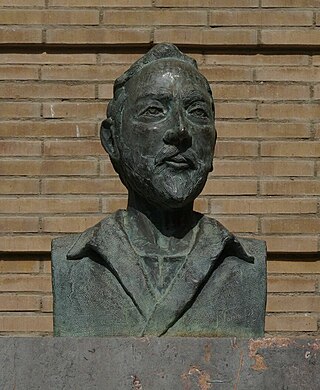
Benjamin of Tudela, also known as Benjamin ben Jonah, was a medieval Jewish traveler who visited Europe, Asia, and Africa in the twelfth century. His vivid descriptions of western Asia preceded those of Marco Polo by a hundred years. With his broad education and vast knowledge of languages, Benjamin of Tudela is a major figure in medieval geography and Jewish history.

The Sultanate of Muscat and Oman, also known briefly as the State of Muscat and Oman during the rule of Taimur bin Feisal, was a sovereign state that encompassed the present-day Sultanate of Oman and parts of present-day United Arab Emirates and Pakistan, in the second half of the 19th century and 20th century. Ruled by the Busaid dynasty, it was established as a result of the partition of the Omani Empire upon the death of its last ruler Said bin Sultan. The Sultanate transitioned into a new form of government after the palace coup of 23 July 1970 in which the sultan Said bin Taimur was immediately deposed in favor of his son Qaboos bin Said.

Meron is a moshav in northern Israel. Located on the slopes of Mount Meron in the Upper Galilee near Safed, it falls under the jurisdiction of Merom HaGalil Regional Council.
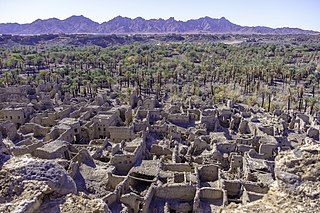
Khaybar is an oasis in Medina Province, Saudi Arabia, situated some 153 kilometres (95 mi) north of the city of Medina. Prior to the arrival of Islam in the 7th century, the area had been inhabited by Arabian Jewish tribes until it fell to Muslim conquerors under Muhammad during the Battle of Khaybar in 628 CE.

The history of the Jews in Bahrain goes back to ancient times. Bahraini Jews constitute one of the world's smallest Jewish communities, although its origins go back to late antiquity. Talmudic sources refer to ports and islands on the Persian Gulf, indicating that Jews may have already settled in this region. Arabic sources record Jews in the old capital of Bahrain, Hajar, at the time of the Islamic conquest in 630 C.E. In the 12th century, the Jewish traveler-adventurer Benjamin of Tudela mentions 500 Jews living in Qays, and 5,000 in Al-Qatîf, involved in pearl fishery. In the 19th century, there were Jewish merchants from Iraq, Persia, and India in Bahrain.

The Habbani Jews are a culturally distinct Jewish population group from the Habban region in eastern Yemen, a subset of the larger ethnic group of Yemenite Jews. The city of Habban had a Jewish community of 450 in 1947, which was considered to possibly be the remains of a larger community which lived independently in the region before its decline in the 6th century. The Jewish community of Habban disappeared from the map of the Hadramaut, in southeast Yemen, with the emigration of all of its members to Israel in the 1950s.

The history of the Jews in Saudi Arabia begins in classical antiquity.

The history of the Jews in Qatar is relatively limited unlike some of the neighboring countries in the Gulf of Persia.
The history of the Jews in the United Arab Emirates describes the historical and modern presence of Jews over the millennia in the Middle East and the recorded meetings with Jewish communities in areas that are today in the geographic territories of the United Arab Emirates.

The history of the Jews in the Arabian Peninsula dates back to Biblical times. The Arabian Peninsula is defined as including the present-day countries of Bahrain, Kuwait, Oman, Qatar, Saudi Arabia, United Arab Emirates and Yemen politically and parts of Iraq and Jordan geographically.
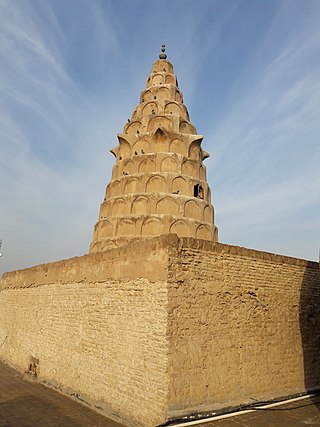
Ezekiel's Tomb is revered by Jews as the resting place of Ezekiel, an Israelite prophet who was deported from the Kingdom of Judah during the Babylonian captivity and serves as the eponymous protagonist of the Book of Ezekiel in the Hebrew Bible. Historically the oldest and most important Jewish site in Mesopotamia, it is now the location of the Al-Nukhailah Mosque, which was built on top of the original site and holds separate significance for Shia Muslims. The Jewish presence at Ezekiel's Tomb has greatly diminished since the Jewish exodus from Iraq in the 1950s, shortly after the beginning of the Arab–Israeli conflict. The larger complex has been extensively redeveloped since the 2003 invasion of Iraq; it is widely regarded by Muslims to be the resting place of Dhul-Kifl, an unknown Islamic prophet who is often identified with Ezekiel, and work was reportedly underway to convert the site's disused synagogue into a mosque.

An-Nabi Samwil, also called al-Nabi Samuil, is a Palestinian village in the Quds Governorate of the State of Palestine, located in the West Bank, four kilometers north of Jerusalem. The village is built up around the Mosque of Nabi Samwil, containing the Tomb of Samuel; the village's Palestinian population has since been removed by the Israeli authorities from the village houses to a new location slightly down the hill. The village had a population of 234 in 2017.

Meiron was a Palestinian village, located 5 kilometers (3.1 mi) west of Safad. Associated with the ancient Canaanite city of Merom, excavations at the site have found extensive remains from the Hellenistic and Early Roman periods. The remains include a 3rd-century synagogue, and Meiron served as a prominent local religious centre at the time.

The Omani Empire was a maritime empire, vying with Portugal and Britain for trade and influence in the Persian Gulf and Indian Ocean. After rising as a regional player in the 18th century, the empire at its peak in the 19th century saw its influence or control extend across the Strait of Hormuz to modern-day Iran and Pakistan, and as far south as Cape Delgado. After the death of Said bin Sultan in 1856 the empire was divided between his sons into two sultanates, an African section ruled by Majid bin Said and an Asian section ruled by Thuwaini bin Said.

The Yarubid dynasty were rulers of Oman between 1624 and 1742, holding the title of Imam. They expelled the Portuguese from coastal strongholds in Muscat and united the country. They improved agriculture, expanded trade and built up Oman into a major maritime power. Their forces expelled the Portuguese from East Africa and established long-lasting settlements on Zanzibar, Mombasa and other parts of the coast. The dynasty lost power during a succession struggle that started in 1712 and fell after a prolonged period of civil war.
Ahmad bin Said al-Busaidi was the first ruler of Oman of the Al Said dynasty. He came to power during a period when Oman was divided by civil war, and the Persians had occupied large parts of the country. During his long rule as Imam the country prospered and regained its leading position in the Persian Gulf.

The Nabhani dynasty, members of the Bani Nabhan family, also referred to as the Sultans of Sohar, were rulers of Oman from 1154 until 1624, when the Yaruba dynasty took power. One of their most visible legacies is the Bahla Fort, a large complex of mud brick buildings on stone foundations built from the 12th to the 15th century. It was registered in 1987 as a UNESCO World Heritage Site.